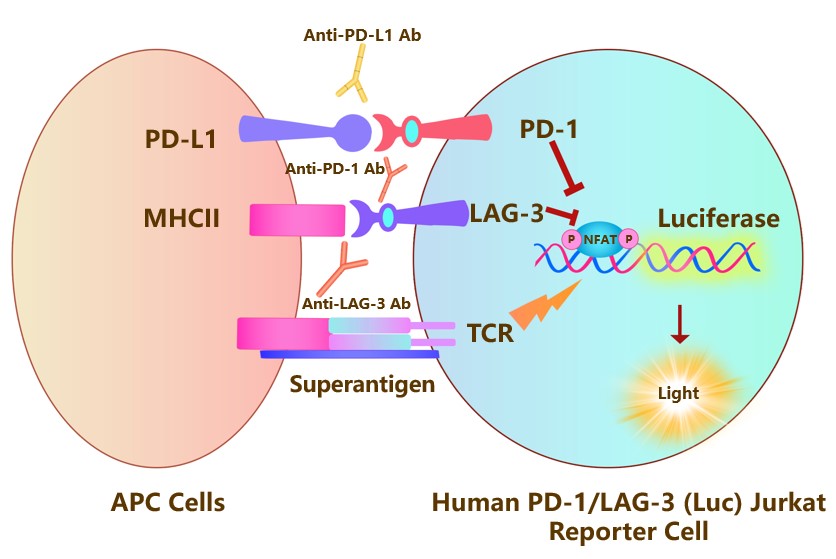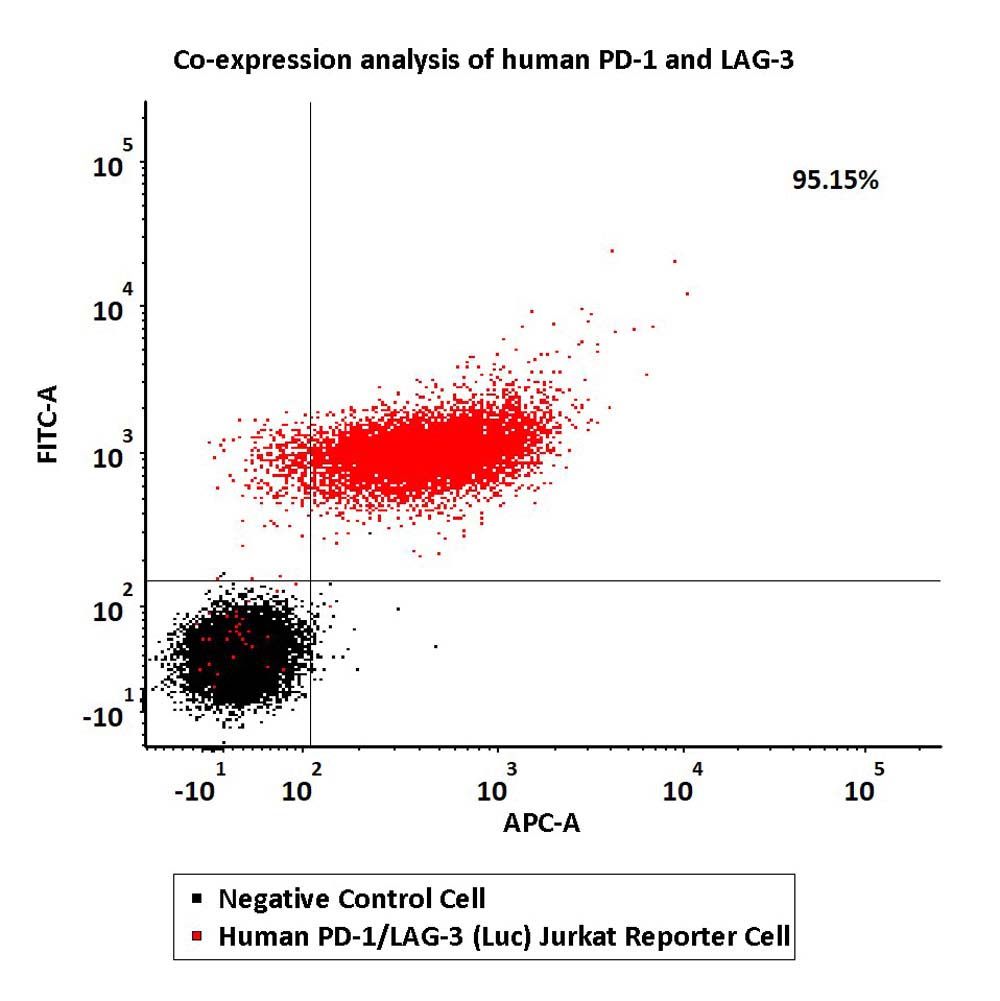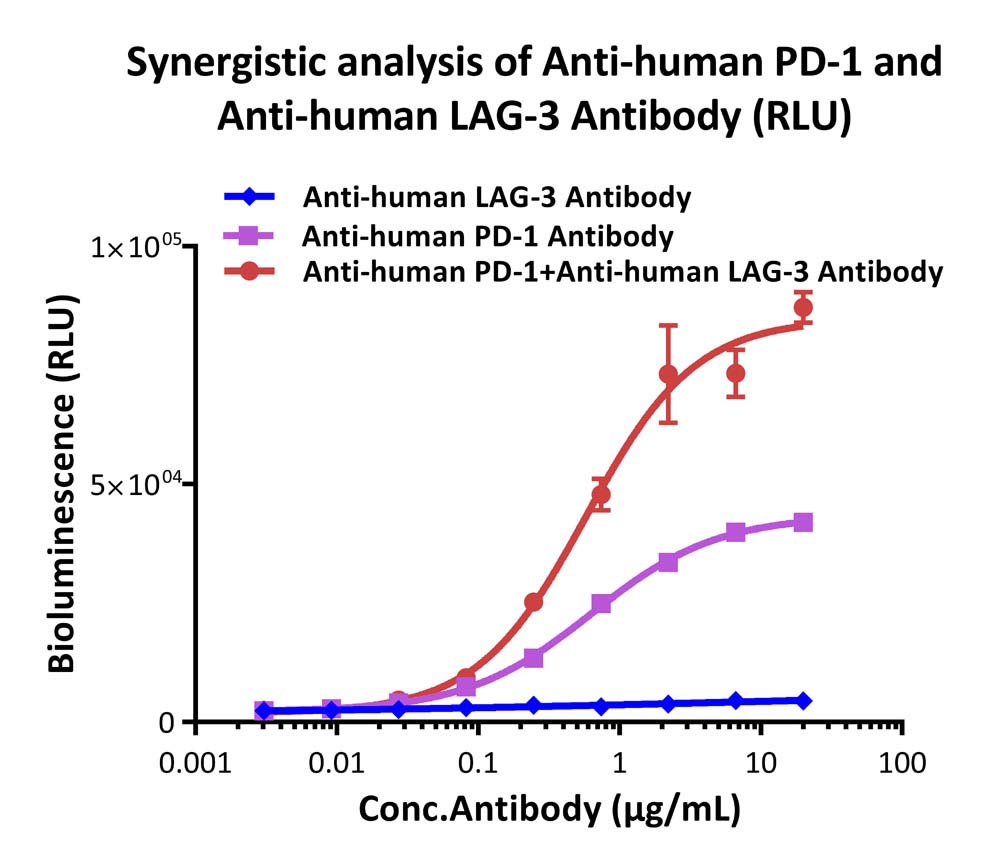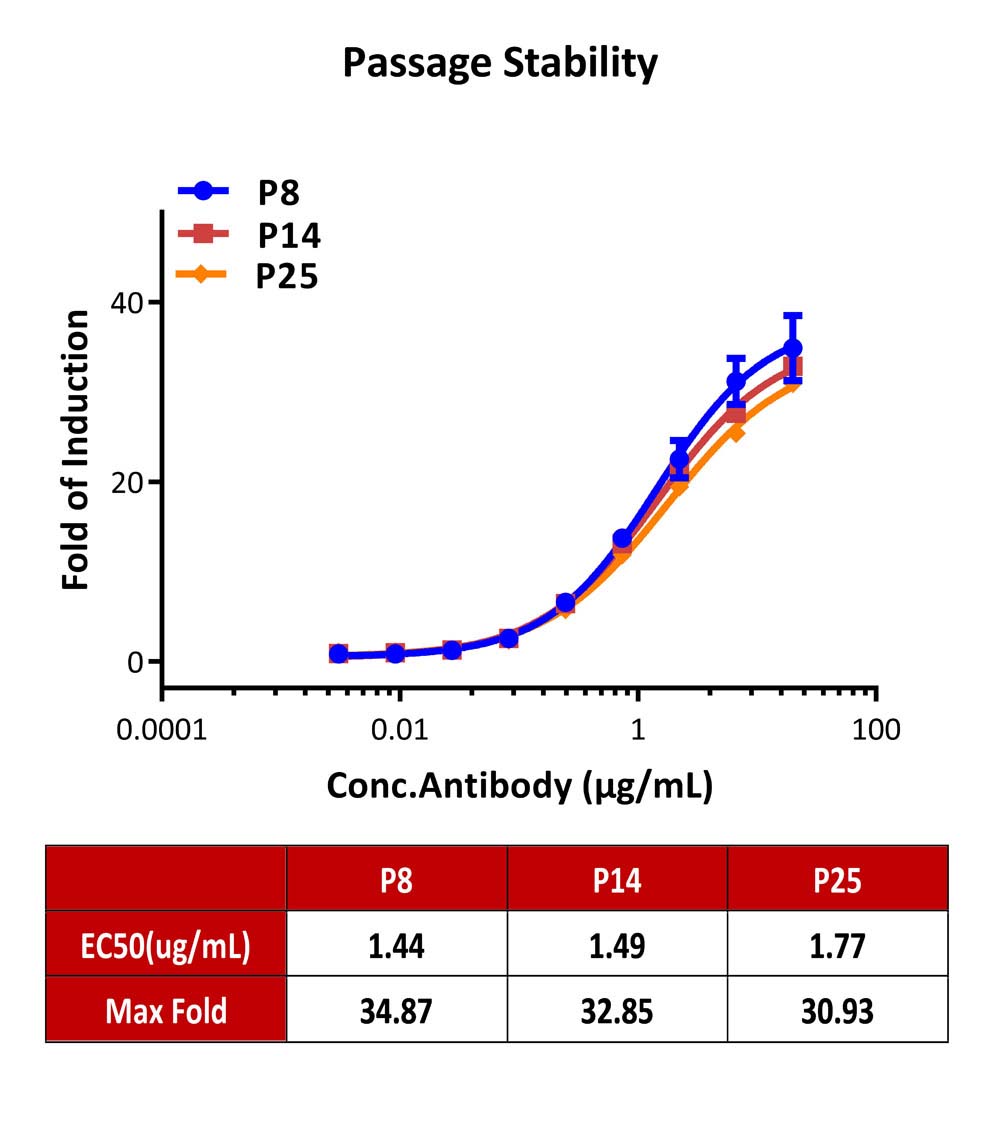- Genetically modified cell lines best reflect MOA (Mechanism of Action)
- Higher activity and larger assay window for robust and reproducible cell-based bioassay
- Comprehensive application data to support assay development and validation
- Full tracible record, stringent quality control and validated cell passage stability
- Parental cell line legally obtained from internationally recognized cell resource bank and commercially licensed
- Global commercial license assistance whenever regulatory filing is required
描述(Description)
The Human PD-1/LAG-3 (Luc) Jurkat Reporter Cell was engineered to not only express the NFAT response element driving luciferase expressing systems, but also express the receptors full length human PD-1 (Gene ID: 5133) and LAG-3 (Gene ID: 3902), which can use to evaluate the synergistic effect of anti-human PD-1 and anti-human LAG-3 antibody. When co-cultured with target cells expressing human PD-L1 and MHCⅡ, the PD-1/PD-L1 and LAG-3/MHCⅡ interactions inhibit TCR signaling and NFAT-mediated luminescence. Blocking the PD-1/PD-L1 and LAG-3/MHCⅡ interactions by the stimultaneous addition of anti-PD-1 or anti-PD-L1 and anti-LAG-3 antibodies release the inhibitory signals and result in TCR activation and NFAT-mediated luminescence.
应用说明(Application)
• Screen for anti-human PD-1 or/and anti-human LAG-3 antibody

生长特性(Growth Properties)
Suspension
筛选标记(Selection Marker)
Puromycin (5 μg/mL) + Hygromycin (20 μg/mL)
培养基(Complete Growth Medium)
RPMI-1640 + 10% FBS
冻存液(Freeze Medium)
Serum-free cell cryopreservation medium
装量(Quantity)
1 vial contains at least 5×10^6 cells in 1 mL serum-free cryopreservation medium
存储(Storage)
Frozen in liquid nitrogen.
支原体检测(Mycoplasma Testing)
Negative
无菌检测(Sterility Testing)
Negative
使用说明(Instructions for Use)
See data sheet for detailed culturing and assay protocol.
质量管理控制体系(QMS)
Receptor Assay

Co-expression analysis of human PD-1 and LAG-3 on Human PD-1/LAG-3 (Luc) Jurkat Reporter Cell by FACS.
Cell surface staining was performed on Human PD-1/LAG-3 (Luc) Jurkat Reporter Cell or negative control cell using FITC-labeled anti-human PD-1 antibody and APC-labeled anti-human LAG-3 antibody.
Protocol
Application

Analysis of the synergistic effect for anti-human PD-1 and anti-human LAG-3 antibody (RLU).
This reporter cell was co-incubated with serial dilutions of anti-human PD-1 plus anti-human LAG-3 antibody in the presence of target cells expressing human PD-L1 and MHCⅡ. The EC50 was approximately 0.58 μg/mL.
Protocol

Analysis of the synergistic effect for anti-human PD-1 and anti-human LAG-3 antibody (FOLD).
This reporter cell was co-incubated with serial dilutions of anti-human PD-1 plus anti-human LAG-3 antibody in the presence of target cells expressing human PD-L1 and MHCⅡ. The max induction fold was approximately 40.
Protocol
Passage Stability

Passage stability analysis by Signaling Bioassay.
The continuously growing Human PD-1/LAG-3 Jurkat Reporter Cell was stimulated with serial dilutions of anti-human PD-1 plus anti-human LAG-3 antibody in the presence of target cells expressing PD-L1 and MHCⅡ. Anti-human PD-1 plus anti-human LAG-3 antibody stimulated response demonstrates passage stabilization (fold induction and EC50) across passage 8-25.
Protocol
如有相关细胞池需求请联系我们
背景(Background)
Programmed cell death protein 1 (PD-1) is also known as CD279 and PDCD1, is a type I membrane protein and is a member of the extended CD28/CTLA-4 family of T cell regulators. PDCD1 is expressed on the surface of activated T cells, B cells, macrophages, myeloid cells and a subset of thymocytes. PD1 inhibits the T-cell proliferation and production of related cytokines including IL-1, IL-4, IL-10 and IFN-γ by suppressing the activation and transduction of PI3K/AKT pathway.
Lymphocyte activation gene 3 protein (LAG3) is also known as CD antigen CD223 and protein FDC, which belongs to immunoglobulin (Ig) superfamily. As a CD4 homologue, LAG3 expressed on the surface of activated conventional T cells and regulatory T (Treg) cells. In conventional T cells, LAG-3 acts as an inhibitory receptor of T cell inflammation.
Limited Use&License Disclosure
BY USE OF THIS PRODUCT, RESEARCHER AGREES TO BE BOUND BY THE FOLLOWING TERMS OF LIMITED USE OF THIS CELL LINE PRODUCT.
- If the researcher is not willing to accept the terms of limited use of this cell line product, and the product is unused, ACRO will accept return of the unused product.
- Researchers may use this product for research use only, no commercial use is allowed. "Commercial use" means any and all uses of this product and derivatives by a party for profit or other consideration and may include but is not limited to use in: (1) product manufacture; and (2) to provide a service, information or data; and/or resale of the product or its derivatives, whether or not such product or derivatives are resold for use in research.
- This cell line is neither intended for any animal or human therapeutic purposes nor for any direct human in vivo use . You have no right to share, modify, transfer, distribute, sell, sublicense, or otherwise make the cell line available for use to other researchers, laboratories, research institutions, hospitals, universities, or service organizations.
- ACROBIOSYSTEMS MAKES NO WARRANTIES OR REPRESENTATIONS OF ANY KIND, EITHER EXPRESSED OR IMPLIED, WITH RESPECT TO THE SUITABILITY OF THE CELL LINE FOR ANY PARTICULAR USE.
- ACROBIOSYSTEMS ACCEPTS NO LIABILITY IN CONNECTION WITH THE HANDLING OR USE OF THE CELL LINE.
- Modifications of the cell line, transfer to a third party, or commercial use of the cell line may require a separate license and additional fees. Please contact order.cn@acrobiosystems.com for further details.























































 膜杰作
膜杰作 Star Staining
Star Staining















